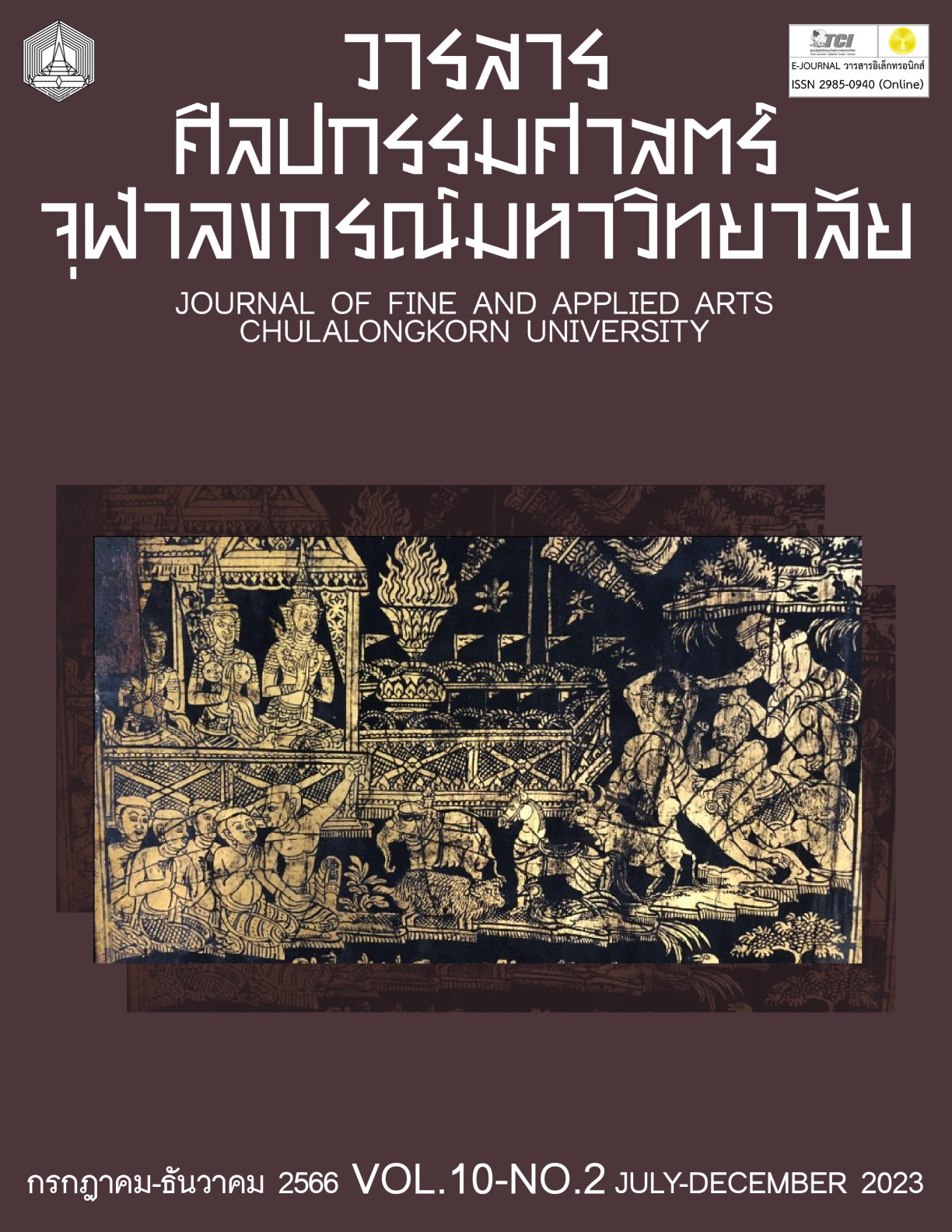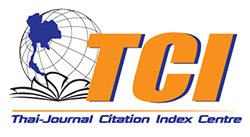THE CREATION OF PII NAI RAUNG TA YAE SONG IN THE WAY OF TEACHER PEEP KONGLAITHONG
Keywords:
Pii nai, The Raung Ta Yae Song, Teacher Peep KonglaithongAbstract
The creation of Pii nai Raung Ta Yae Song in the way of teacher Peep Konglaithong is the qualitative research focusing on the basic of blowing the Pii nai instrument in Raung Ta Yae Song of Praya Sanauoduriyang (Cham Soontharawathin) and synthesizes the results of the research into the creation of Pii nai Raung Ta Yae Song. The Raung Ta Yae Song consists of three songs: 1) Ta Yae song 2) Mon Plang song and 3) Long Rau song. These three songs use the Tang Nai and Tang Nok scale most frequently. Pii nai has a particular way to blow and produce sound is a reason why it is learned by fewer people. This research can help learners improve themselves in the technical aspects of playing the Pii nai. Peep Konglaithong, national artist since 2020, has a particular way of playing the Pii Nai. His melodies are simple and focuses on basic techniques. 8 different techniques were found, which were Kaan Kuang Siang, Kaan Prom Niw, Kaan Tee Niw, Kaan Pao Prib, Kaan Tod Lom, Kaan Kran Lom, Kaan Tod Lin, and Kaan Sabud. These techniques enabled the learner to match their breathe production to the control of their fingers, keeping the structure of the melody. The result of this research was disseminated in the Kong Lai Thong Learners Group and is used to improve the students in the Thai Music skills and Wind Instruments modules at the Faculty of Fine and Applied Arts, Chulalongkorn University and others.
References
Chaiseri, Pichit. Composition of Thai songs. Bangkok: Chulalongkorn University Press, 2013.
พิชิต ชัยเสรี. การประพันธ์เพลงไทย. กรุงเทพมหานคร : สำนักพิมพ์แห่งจุฬาลงกรณ์มหาวิทยาลัย, 2556.
Fakchamroon, Sirichaichan. Thai music. Bangkok: Aksorn Siam, 2003.
สิริชัยชาญ ฟักจำรูญ. ดุริยางคศิลป์ไทย. กรุงเทพมหานคร : อักษรสยามการพิมพ์, 2546.
Kerdphol, Samran. “The Principle of Thai Music Composition.” In The Cremation Volume of Samran Kerdphol, 43-35. Nonthaburi: Yin Yang Printing, 2018.
สำราญ เกิดผล. “หลักการประพันธ์เพลงไทย.” ใน หนังสือที่ระลึกงานพระราชทานเพลิงศพ นายสำราญ เกิดผล, 43-35. นนทบุรี : หยินหยางการพิมพ์, 2561.
Konglaithong, Peep. “Biography.” Interview by Pattara Komkum. August, 24, 2018.
ปี๊บ คงลายทอง. “ชีวประวัติ.” สัมภาษณ์โดย ภัทระ คมขำ. 24 สิงหาคม 2561.
Konglaithong, Peep. “The Characteristics of Blowing Pii nai Instrument in Ta Yae Song.” Interview by Pattara Komkum. December, 3, 2021.
ปี๊บ คงลายทอง. “ลักษณะเฉพาะการเป่าปี่ในเพลงทะแย.” สัมภาษณ์โดย ภัทระ คมขำ. 3 ธันวาคม 2564.
Kumut, Prawet. The Cremation Volume of Prawet Kumut at the Crematorium of Debsirin Temple. Bangkok: Love and Lip Press, 2000.
ประเวช กุมุท. หนังสือที่ระลึกงานพระราชทานเพลิงศพ ครูประเวช กุมุท. กรุงเทพมหานคร : เลิฟแอนด์ลิพ เพรส จำกัด, 2543.
Laddaorn, Sakchai. “The Importance of Ta Yae Song.” Interview by Pattara Komkum. September, 24, 2018.
ศักดิ์ชัย ลัดดาอ่อน. “ความสำคัญของเพลงทะแย.” สัมภาษณ์โดย ภัทระ คมขำ. 24 กันยายน 2561.
Laisakul, Chakrayut. “The Importance of Ta Yae Song.” Interview by Pattara Komkum. August, 24, 2018.
จักรายุธ ไหลสกุล. “ความสำคัญของเพลงทะแย.” สัมภาษณ์โดย ภัทระ คมขำ. 24 สิงหาคม 2561.
Luangsoonthorn, Sanoh. “Kru Sanoh Luangsoonthorn.” In The Commemorative Book of the Wai Kru Ceremony of Thai Music Club, Kasetsart University 2013, 25-26. Bangkok: Aksorn Siam, 2013.
เสนาะ หลวงสุนทร. “ครูเสนาะ หลวงสุนทร.” ใน หนังสือที่ระลึกพิธีไหว้ครูดนตรีไทย ชมรมดนตรีไทยมหาวิทยาลัยเกษตรศาสตร์ ปีการศึกษา 2556, 25-26. กรุงเทพมหานคร : อักษรสยามการพิมพ์, 2556.
Meepom, Dussadee. “The Solo Song.” In The Cremation Volume of Kru Pring Kanjanapalin at the Crematorium of Pracha Satthatham Temple, 88. Bangkok: Rak Sip, 1986.
ดุษฎี มีป้อม. “เพลงเดี่ยว.” ใน หนังสือที่ระลึกงานพระราชทานเพลิงศพครูพริ้ง กาญจนผลิน ณ เมรุวัดประชาศรัทธาธรรม (เสาหิน), 88. กรุงเทพมหานคร : รักษ์สิปป์, 2529.
Pornprasit, Kumkom. “Pleng Ching: The Study of History and Styles.” Research Report, Ratchadapisek Sompoch Fund, Chulalongkorn University, 2002.
ขำคม พรประสิทธิ์. “อัตลักษณ์ของเพลงฉิ่ง.” รายงานการวิจัย, กองทุนวิจัยรัชดาภิเษกสมโภช จุฬาลงกรณ์มหาวิทยาลัย, 2545.
Sobreuk, Anan. “The Roles and Duties of Pii in Thai Classical Band.” In History and Development of the Thai Pii, 43. Nakhon Pathom: Mahidol University Press, 1990.
อนันต์ สบฤกษ์. “บทบาทและหน้าที่ของปี่ในวงดนตรีไทย.” ใน ประวัติและพัฒนาการของปี่ไทย, 43, นครปฐม : สำนักพิมพ์มหาวิทยาลัยมหิดล, 2533.
Thaworn, Prasit. The Commemorative Book on the Occasion of Showing Gratitude towards Ajarn Prasit Thaworn. Bangkok: Rak Sip, 1989.
ประสิทธิ์ ถาวร. หนังสือที่ระลึกในโอกาสแสดงมุทิตาจิตของศิษย์อาจารย์ประสิทธิ์ ถาวร. กรุงเทพมหานคร : รักษ์สิปป์, 2532.
The Fine Arts Department. The Commemorative Book of 100th Anniversary of Jangwangtua Phatyakosol. Bangkok: Amarin, 1981.
กรมศิลปากร. สูจิบัตรงานที่ระลึกเนื่องในโอกาสวันเกิดครบ 100 ปี จางวางทั่ว พาทยโกศล. กรุงเทพมหานคร : อมรินทร์, 2524.
The Royal Society of Thailand. Encyclopedia of Thai Music terms, History and Thai lyrics. 3rd edition. Bangkok: the Royal Society of Thailand, 2001.
ราชบัณฑิตยสถาน. สารานุกรมศัพท์ดนตรีไทย ภาคประวัติและบทร้องเพลงเถา. พิมพ์ครั้งที่ 3. กรุงเทพมหานคร : ราชบัณฑิตยสถาน, 2544.
Tramote, Montri. “Duriyasan.” In The Cremation Volume of Montri Tramote, 37-38. Bangkok: Kasikorn Bank, 1995.
มนตรี ตราโมท. “ดุริยสาส์น.” ใน หนังสือที่ระลึกงานพระราชทานเพลิงศพนายมนตรี ตราโมท, 37-38. กรุงเทพมหานคร : ธนาคารกสิกรไทย จำกัด, 2538.
Tramote, Montri. Thai Music Theory. 2nd edition. Bangkok: Matichon, 1997.
มนตรี ตราโมท. ดุริยางคศาสตร์ไทย ภาควิชาการ. พิมพ์ครั้งที่ 2. กรุงเทพมหานคร : มติชน, 2540.
Tramote, Montri and Wichian Kultan. Listening to and Understanding Thai Music. Bangkok: Thai Khasem, 1980.
มนตรี ตราโมท และ วิเชียร กุลตัณฑ์. ฟังและเข้าใจเพลงไทย. กรุงเทพมหานคร : ไทยเขษม, 2523.
Downloads
Published
Issue
Section
License
Copyright (c) 2023 PATTARA KOMKUM

This work is licensed under a Creative Commons Attribution-NonCommercial-NoDerivatives 4.0 International License.
ลิขสิทธิ์ของบทความเป็นของเจ้าของบทความ บทความที่ได้รับการตีพิมพ์ถือเป็นทัศนะของผู้เขียน
กองบรรณาธิการไม่จำเป็นต้องเห็นด้วยและไม่รับผิดชอบต่อบทความนั้น






